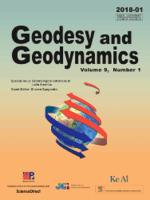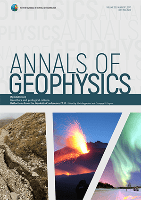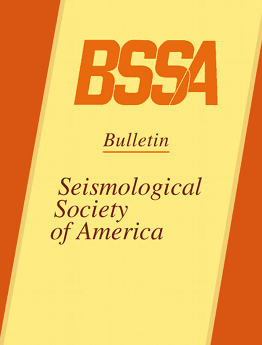
Geodesy and Geodynamics
Scope & Guideline
Unraveling Earth's Mysteries Through Innovative Research.
Introduction
Aims and Scopes
- Geodetic Measurements and Techniques:
This area includes advancements in GNSS (Global Navigation Satellite Systems), InSAR (Interferometric Synthetic Aperture Radar), and other remote sensing techniques for monitoring Earth's movements and deformations. - Earthquake Dynamics and Geophysical Modeling:
Research in this scope focuses on understanding the mechanisms of earthquake generation, including seismic hazard assessments, fault modeling, and the study of stress transfer mechanisms. - Hydrology and Water Storage Dynamics:
This theme encompasses studies on terrestrial water storage changes, hydrological impacts on geodetic measurements, and the influence of water bodies on Earth's crustal movements. - Tectonic Processes and Crustal Deformation:
This area deals with the analysis of tectonic activities, crustal deformation, and the study of active tectonics using geodetic data to understand regional geological stability. - Geoid and Gravity Field Analysis:
Research in this category involves modeling and measuring the geoid, analyzing gravity data, and understanding the implications for geodynamics and sea level changes. - Environmental and Climate Change Impacts:
This scope includes studies that assess the impact of climate change on geodesy, such as land subsidence, urban heat islands, and changes in terrestrial water storage.
Trending and Emerging
- Integration of Machine Learning and AI in Geodesy:
There is a growing trend in utilizing machine learning and artificial intelligence techniques for data analysis, anomaly detection, and predictive modeling in geodesy, enhancing the accuracy and efficiency of geodetic assessments. - Climate Change Adaptation Studies:
Research exploring the impacts of climate change on geodetic measurements, such as sea-level rise and land subsidence due to hydrological changes, is gaining traction as environmental concerns become more pressing. - Real-time Monitoring and Early Warning Systems:
Emerging themes include the development of real-time monitoring systems for seismic activity and land deformation, driven by advancements in GNSS and remote sensing technologies. - Interdisciplinary Approaches to Geodynamics:
There is an increasing emphasis on interdisciplinary research that combines geodesy with geology, hydrology, and environmental science to address complex geodynamic problems. - Advanced Modeling Techniques:
The journal is witnessing a rise in studies that employ sophisticated numerical modeling techniques to simulate geophysical processes, providing deeper insights into tectonic and hydrological interactions.
Declining or Waning
- Traditional Geodetic Techniques:
There seems to be a decline in research focused solely on traditional geodetic techniques, such as classical triangulation and leveling methods, as more advanced technologies like GNSS and InSAR gain dominance. - Basic Gravity Measurements:
Research centered around basic gravity measurements without integration into broader geodynamic models is less frequent, suggesting a move towards more complex analyses that incorporate multidisciplinary approaches. - Static Geodesy Studies:
The focus on static geodesy, which involves measurements that do not account for temporal changes, appears to be declining in favor of dynamic studies that consider ongoing geophysical processes.
Similar Journals

Acta Geodaetica et Geophysica
Unveiling the Dynamics of Earth's ProcessesActa Geodaetica et Geophysica is a prestigious journal published by Springer, focusing on the interdisciplinary domains of geodesy, geology, and geophysics. With an ISSN of 2213-5812 and E-ISSN of 2213-5820, this journal serves as a vital resource for researchers, professionals, and students interested in building and construction, as well as the broader aspects of Earth and planetary sciences. Operating since 2013 and poised to continue until 2024, Acta Geodaetica et Geophysica has consistently maintained its relevance within the academic community, evidenced by its Q3 quartile ranking in the fields of Building and Construction, Geology, and Geophysics for 2023. The journal's Scopus ranks highlight its competitive standing, ranking 118 out of 321 in Geology, and 66 out of 165 in Geophysics, reflecting its impactful contributions to the field. Although this journal does not offer open access, it remains an essential publication that enriches ongoing research and promotes knowledge dissemination in Hungary and beyond. Researchers and academics seeking to advance their studies will find valuable insights and rigorous analyses within its pages, making it a cornerstone of contemporary geoscience literature.

GEOTECTONICS
Unveiling the Dynamics of Our Planet's Tectonic Systems.GEOTECTONICS is a distinguished academic journal published by PLEIADES PUBLISHING INC, focusing on key developments in the field of geology. Established in 1978, the journal has dedicated itself to exploring the intricate processes and phenomena associated with Earth's tectonic systems, making substantial contributions to Earth and Planetary Sciences. With an impressive impact factor reflected in its Q2 ranking within the Scopus category of Geology, GEOTECTONICS stands out as a valuable resource for researchers, professionals, and students alike. The journal offers a platform for rigorous peer-reviewed research that spans both fundamental theories and practical applications in geosciences, affirming its significance in fostering academic discourse and advancing geological knowledge. Although it currently does not offer open access, the journal's accessible format and continued publication through to 2024 ensures that it remains at the forefront of geoscientific inquiry.

ANNALS OF GEOPHYSICS
Connecting Researchers to the Heart of GeophysicsANNALS OF GEOPHYSICS is a prestigious open access journal dedicated to the advancement and dissemination of research in the field of geophysics. Published by the IST NAZIONALE DI GEOFISICA E VULCANOLOGIA in Italy, this journal has embraced open access since its inception in 1948, promoting wide accessibility to cutting-edge research. With an impressive Scopus ranking, placing it in the 52nd percentile within Earth and Planetary Sciences for the category of Geophysics, the journal serves as a vital platform for scholars, researchers, and practitioners seeking to explore the intricate phenomena of our planet. Covering a diverse range of topics in the geophysical community, the ANNALS OF GEOPHYSICS invites contributions that push the boundaries of our knowledge and understanding of geophysical processes, aiding in the development of innovative solutions to urgent environmental challenges. Published continuously from 2002 to 2024, the journal’s commitment to quality and rigor is reflected in its Q3 quartile ranking for 2023, making it a notable resource for the academic community.

Journal of Asian Earth Sciences-X
Fostering Collaboration for Sustainable Earth SolutionsJournal of Asian Earth Sciences-X, a distinguished publication by ELSEVIER, is at the forefront of Earth and planetary sciences, particularly focusing on the dynamic fields of geology and earth-surface processes. As an Open Access journal since 2019, it provides unparalleled access to high-quality research, fostering global collaboration and dissemination of knowledge. With an impressive impact factor and ranking in the Q2 category for both Earth-Surface Processes and Geology, it serves as a crucial platform for researchers, professionals, and students alike to share their findings and insights. Situated in the United Kingdom, the journal thrives on contributions that enhance our understanding of Asian geosciences within a broader global context, aiming to tackle major challenges such as climate change and natural resource management. By bridging regional studies with global perspectives, the Journal of Asian Earth Sciences-X is not only a vital resource for academia but also supports sustainable development initiatives across the region.

Solid Earth Sciences
Unveiling the mysteries beneath our feet.Solid Earth Sciences is a dynamic open-access journal published by Elsevier, dedicated to advancing our understanding of the Earth's subsurface processes and materials. Since its inception in 2016, the journal has established itself as a vital resource for researchers and professionals in the fields of geochemistry, petrology, geology, geophysics, and geotechnical engineering, achieving a notable Q2 ranking in multiple categories as of 2023. With an ISSN of 2451-912X, the journal aims to disseminate high-quality research that enhances knowledge of earth surface processes and the intricate interactions within our planet's systems. The journal is indexed in Scopus, showcasing an impressive rank in various sub-disciplines, with a rank of #96 in Geology and a noteworthy percentile in Earth and Planetary Sciences. Solid Earth Sciences offers a platform for innovative studies, comprehensive methodologies, and cutting-edge technological advancements that cater to a global audience of scientists, academics, and students. With its commitment to open access, it fosters wider dissemination and impact of research outcomes, ensuring that pivotal discoveries reach stakeholders and contribute to real-world applications.

GEOCHEMISTRY GEOPHYSICS GEOSYSTEMS
Transforming Geoscience Through Open Access ScholarshipGEOCHEMISTRY GEOPHYSICS GEOSYSTEMS, published by the American Geophysical Union, is a leading open-access journal that has been at the forefront of advancing our understanding of earth sciences since its inception in 2000. With an impressive open access policy established in 2022, the journal promotes the wide dissemination of high-quality research in the fields of Geochemistry and Geophysics. Boasting a Q1 ranking in both Geochemistry and Petrology, as well as Geophysics, in the 2023 Journal Rankings, it is recognized among the top journals in its categories, positioning itself at the cutting edge of scientific inquiry. The journal has also secured notable rankings in Scopus, placing it in the 83rd percentile for Geophysics and the 71st percentile for Geochemistry and Petrology, reflecting its impact and relevance within the scientific community. Located in Washington, DC, GEOCHEMISTRY GEOPHYSICS GEOSYSTEMS serves as a vital resource for researchers, professionals, and students dedicated to the exploration of the complex interactions of geochemical and geophysical processes.

EARTH PLANETS AND SPACE
Unveiling the Mysteries of Our Planet and the CosmosEARTH PLANETS AND SPACE, published by Springer and based in Switzerland, is a distinguished journal that plays a pivotal role in advancing the fields of Earth and planetary sciences. With an impactful presence in both geology (Q1) and space and planetary science (Q2), this journal is increasingly recognized for its contributions to understanding complex geoscientific processes and extraterrestrial phenomena. The journal has been a vital resource for researchers since its inception in 1996 and is anticipated to continue this legacy until at least 2024. It ranks impressively within the Scopus database, holding the 53rd position out of 321 in Earth and Planetary Sciences for Geology and the 30th position out of 104 for Space and Planetary Science, reflecting a robust percentile standing of 83 and 71, respectively. With open access options available, EARTH PLANETS AND SPACE makes cutting-edge research more accessible to a global audience, fostering collaboration and innovation. This journal is essential for anyone seeking to deepen their knowledge or stay current with trends in Earth sciences and planetary exploration.

Artificial Satellites-Journal of Planetary Geodesy
Unlocking Planetary Mysteries with Satellite TechnologyArtificial Satellites-Journal of Planetary Geodesy is a pivotal academic journal dedicated to the field of planetary geodesy, focusing on the intersection of satellite technology and planetary sciences. Published by SCIENDO, this journal, with an ISSN of 0208-841X and an E-ISSN of 2083-6104, offers comprehensive insights into current research developments through peer-reviewed articles. Operating under an open-access model, the journal is accessible to a wide audience, fostering a collaborative environment among researchers and practitioners worldwide. Established in 2009, it has emerged as a significant resource, ranking in the Q4 category for Space and Planetary Science and recognized in the Scopus database, placing it within the 12th percentile among earth and planetary sciences journals. The journal's objective is to advance knowledge in the application of satellite technology to planetary studies, making it an essential platform for innovative research, methodological advancements, and interdisciplinary dialogues for professionals, researchers, and students in the field.

Geofizicheskiy Zhurnal-Geophysical Journal
Pioneering Knowledge in Seismic Studies and BeyondGeofizicheskiy Zhurnal-Geophysical Journal, published by the esteemed S I Subbotin Institute of Geophysics, National Academy of Sciences of Ukraine, stands as a vital resource for professionals and researchers in the field of geophysics. With an ISSN of 0203-3100 and an E-ISSN of 2524-1052, this journal is recognized for its rigorous peer-reviewed articles that delve into various aspects of geophysical research, including seismic studies, geodynamics, and Earth surface processes. Although currently not under an open access model, the journal maintains a commitment to disseminating high-quality research, thereby enriching the global geophysical community. The publication aims to foster collaboration and knowledge transfer among scientists and engineers while addressing complex geophysical challenges in a rapidly evolving landscape. By engaging with cutting-edge research, readers can expect to uncover insights that advance both theoretical understanding and practical applications in geophysical science.

BULLETIN OF THE SEISMOLOGICAL SOCIETY OF AMERICA
Elevating the standards of seismological research since 1969.BULLETIN OF THE SEISMOLOGICAL SOCIETY OF AMERICA is a premier journal published by the Seismological Society of America, dedicated to advancing research in the field of seismology and related disciplines. Since its inception in 1969, this journal has garnered significant recognition, evidenced by its impressive Q1 category rankings in both Geochemistry and Petrology, and Geophysics, alongside a solid standing within the Earth and Planetary Sciences Scopus rankings. The journal is esteemed for publishing high-quality, peer-reviewed articles that contribute to the understanding of seismic activities and their implications on a global scale. With a commitment to facilitating the dissemination of critical findings, it serves as an essential resource for researchers, professionals, and students alike who are engaged in the dynamic and vital study of the Earth’s processes. While the journal is not Open Access, it continues to provide vital insights and methodologies that shape the future of geophysical research.